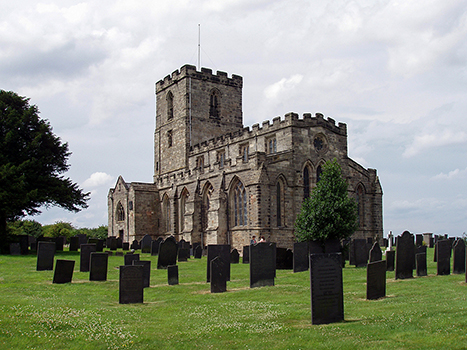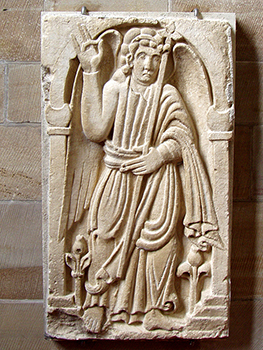BREEDON ON THE HILL, LEICESTERSHIRE
Grid Ref: SK 405 233
19 July 2003
Breedon on the Hill is in the north west of Leicestershire close to the boundary
with Derbyshire. The site has been occupied since at least the new Stone Age
or early Bronze age, became an Iron Age hill fort and then a Roman settlement.
The outcrop of limestone and dolomite has been quarried on the southern side
so that when viewed from a distance the church appears to stand at the top of
a cliff. The Parish Church of St. Mary and St. Hardulph is known for its magnificent
collection of Saxon carvings and for its associations with the history of Christianity
in the Midland counties.
Christianity came to the central region of England from Northumbria, where
it had been reintroduced by Celtic monks from Ireland. In 653, Elfleda, daughter
of King Oswy of Northumbria, married Peada, son of King Penda who became a Christian
and was baptised by Finan, Bishop of Lindisfarne. Peada became the first Christian
King of all of Mercia. Peada and Oswy then founded a monastery dedicated to
St. Peter at Medehamstede, modern Peterborough. Peada was succeeded by his brothers,
Wulfhere and then Aethlred, who ruled until 704. The Anglo-Saxon Chronicle relates
that he gave further lands to the monastery at Peterborough including Breedon.
Friduric was charged with founding a new monastery there and Hedda, a priest
from Medehamstede, became the first abbot. They were required to take on missionary
work in the area and such churches were known as minsters. The Venerable Beede
noted that Tatwin, a monk from Breedon, became Archbishop of Canterbury in 731.
It is known that the Danish invasions reached Repton, only seven miles from
Breedon, where they stayed over the winter in 874. The Bishop of Leicester fled
to Dorchester on Thames. Later, at the end of
the 9th century, and during the 10th century, the Danes were converted to Christianity
and there are fragments of stone carvings from this date on display in the church.
After 1066, Breedon was given by William I to Robert de Ferrers, who became
the 1st Earl of Derby. Around 1109 to 1122, Robert gave the church, which may
have been the remains of the Saxon minster church, to Nostell Priory in Yorkshire,
an Augustinian foundation. This led to new building work at Breedon which may
have been onto the existing buildings and included a cloister. The lower part
of the tower dates from this period. There are marks on three sides of the current
tower showing where the pitched roofs of earlier buildings abutted it. The upper
part of the tower appears to have been rebuilt in the 13th century. By the early
16th century the nave and the porch, used as the parish church, were in a poor
state of repair. In 1539, at the Dissolution, there was the parish church, the
priory church east of the central tower and the domestic range of buildings.
Francis Shirley of Staunton purchased the site and the parishioners requested
that as their church was falling down they should make a church out of elements
of the priory, including the tower and the chancel to the east. The former parish
church was then pulled down and some of the Saxon carved stones were built into
the new porch. In 1937 they were removed from the porch and set around the inside
of the church for preservation.
The current church is therefore presents a complex picture. The current nave
was the chancel of the priory church. The North aisle contains a squint to give
a view of the altar from former monastic buildings on that side of the chancel.
This aisle contains the Shirley Pew and the Shirley Monument. At the east end
of the South Aisle is the Lady Chapel. The porch, at the south-west corner is
adjacent to the tower and the room above it, now the vestry, was once a school.
The former parish church was west of the tower.
The priors of Breedon date from Elias between 1153 and 1160 to the last prior,
Henry Huntingdon who was appointed in 1537. The vicars of Breedon are known
back to 1244.
The Shirley Monument
The east end of the north aisle is dominated by a huge monument to members
of the Shirley family that bought the site at the Dissolution. The monument
was erected by Sir George Shirley to his father, John Shirley, who died aged
35 in 1570 and also to his wife, Francisca, who died aged 31 on 29 December
1595. Sir George is also buried there. The monument was erected in 1598.
Sources:
St. Mary and St. Hardulph Church, Breedon on the Hill, by Brian
C. J. Williams A.T.D. M.Phil, printed in 1996 by Hawthornes Printers of Nottingham.
This is a 32-page booklet, available in the church, which gives a comprehensive
account of the history of the church and describes in detail the Saxon carvings.








